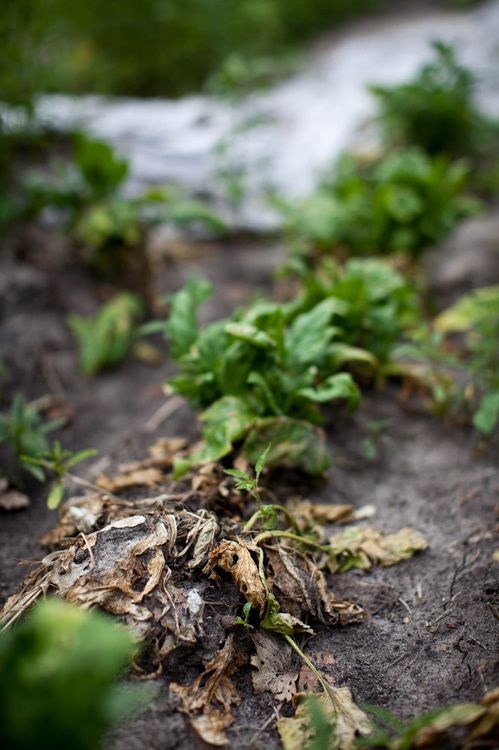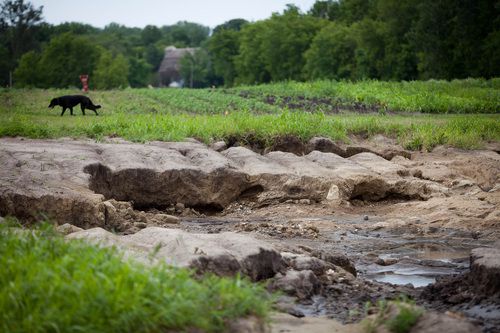
In mid-June flooding at Laughing Loon Farm, near Northfield, Minn., washed away soil and plants. (MPR Photo/Jennifer Simonson)
In the June 14 flood in Dakota, Goodhue and Rice counties, a third of Dayna Burtness’ Laughing Loon Farm was washed away. But there was still a chance the first-year full-time farmer could make a go of it at her herb, flower, and vegetable farm in Northfield , which supports local restaurants and St. Olaf college with produce.
Then a hail storm hit three days later and she knew she was in big trouble. She lost thousands of dollars in equipment and ready-to-be planted vegetables, most of the peppers, the eggplants, and many beds of beans, beets, spring mix, and spinach. Even where some vegetables appear to be making a go of it today, Burtness is counting it as a loss because she doesn’t know what pollutants were in the floodwater and hers is a farm that stresses organic and sustainable practices.
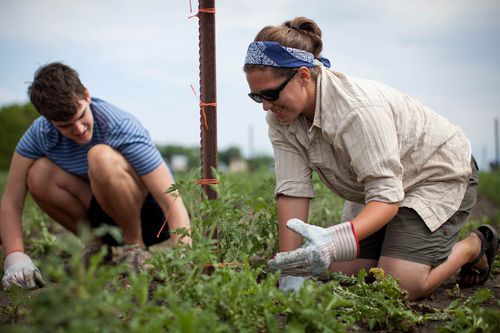
Laughing Loon Farm owner Dayna Burtness, right, and volunteer Louis Tafte, who works at the Bachelor Farmer restaurant, weed tomato plants Tuesday, June 26, 2012 on the farm’s five acres near Northfield, Minn. Flooding and hail damaged the crops in June, but Burtness hopes to save the tomatoes by pulling weeds and fertilizing them with composted chicken manure. (MPR Photo: Jennifer Simonson)
It was a quick fall from lofty heights. Just a few weeks ago, her work fed a president and his guests at the Bachelor Farmer restaurant in Minneapolis on a presidential swing through the Twin Cities.
The region south of the Twin Cities got a little bit of attention after the flooding, but then the flash floods struck the Duluth area, and the attention shifted north, leaving Burtness on her own. She had to lay off one employee, leaving her only with two additional helpers, and her dog.
There is no flood disaster assistance from the usual sources, either. She couldn’t get crop insurance, she says, because figuring out a value involves five years of crop results and this is her first full year.
There’s still a little bit of the farm left on the land she rents, but the race is on to save the young crops that are left on land. Much of the topsoil has washed away and a nearby creek left only a pile of sand.
“I did some crying and puking,” she said today, the first day she would find out if her plea for help would be answered. It was.
Up until today, it’s been too wet to get into the fields to start trying to save what’s left. A call for volunteers was answered today by about a dozen people who heard of Ms. Burtness’ ordeal. An organic farmer from Hutchinson showed up, so did some local students, and a retired 3M’er pitched in.
This morning, the team alternated between adding chicken manure to bruised tomato plants and pulling weeds and thistle from the rows. The land is scarred and the tomato plants will struggle to survive, especially with competition from the invaders. Potato beetles have also showed up this week to add another challenge.
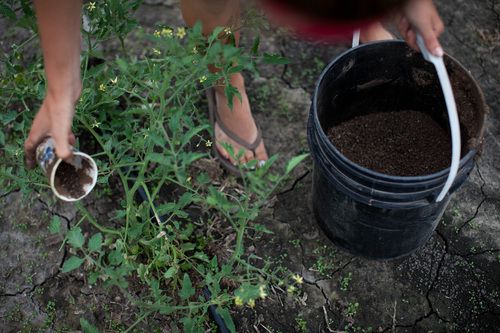
Laughing Loon Farm intern Nicole Klein, a student at St. Olaf College, side dresses tomato plants with composted chicken manure.(MPR Photo/Jennifer Simonson)
Things didn’t look good last weekend, “but the plants have pepped up a bit in the last few days,” Burtness says. She says of the the crops that are left, about half the income-making potential is with the tomatoes.
During a lunch break this afternoon, Burtness acknowledged her spirits have pepped up a bit in the last few days, too.

Volunteers help Laughing Loon farmer Dayna Burtness weed and side dress her tomato plants Tuesday, June 26, 2012 near Northfield, Minn. Floods and hail in mid June damaged or destroyed some of the farm’s crops.(MPR Photo/Jennifer Simonson)
There’ll be another volunteer day either late this week or on the weekend. To learn more, visit the Laughing Loon website.
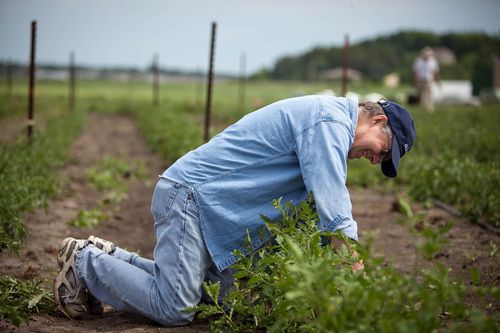
Blogger takes out his frustrations on thistle with bad intentions.(MPR Photo/Jennifer Simonson)


